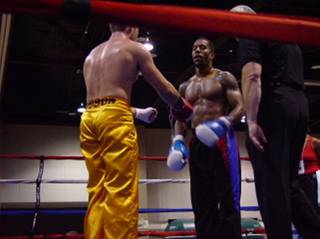
"To fight with people face to face over advantages is the hardest thing in the world to do." Zhang Yu
Being ready for a competitive martial arts tournament, and being ready for physical confrontation on the streets is not like the other; one should not think they are one in the same. The rules of engagement are quite different for both, along with the consequences.
A tournament is governed by established rules which provide entertainment for spectators, and protection and fair practices for competitors. There are judges and referees to mediate the action, coaches to counsel the athletes, and parents and friends who cheer. Fighters are expected to exhibit good sportsmanship and respect toward their fellow opponents, or at the very least be able to fake it. Although there is a risk of sustaining serious injury during a match, most tournaments require competitors to wear protective sparring gear (i.e. headgear, mouth piece, instep and shin guards, chest protectors, forearm guards, groin protector, wraps, gloves, etc.) Fighters that are stunned by a particularly hard blow are often given eight counts to collect themselves; saving them from an experience that might have otherwise put their consciousness on a vacation. If push comes to shove, a fighter can throw in the towel, and simply walk away. With all these measures in place rarely does injury result in death.
In contrast, street fighting is unpredictable and often brutally savage. The rules are there are no rules. When I was a little boy growing up in Philadelphia, I witnessed a teenage boy try to fend off four guys that literally beat him within half an inch of his life. Both his legs were shattered with an iron crowbar, and he was punched in the face until he was unresponsive. I am telling this story not for entertainment purposes, but to emphasize the stark differences between street fighting and tournament sparring. Attacks on the street come without warning, judges, referees, protective equipment, and rules. The objective is not to score points; it is to hurt someone, often to the point that death is a real imminent possibility. Lose a fight in the ring, you can come back to fight another day. Lose a fight in the streets, and there might not be another day.
In a tournament there are no losers, short of someone who does not give their all. Sure, some participants will be outfitted with belts, medals, trophies, and other awards, but the experience of competing and the shared interest and camaraderie is the true reward to be had by all. In real life confrontations, everyone is a loser and there are only survivors. Even if you successfully fend off an attacker on the streets, I think you lose a little bit of your compassion, trust, and forgiveness. I can personally tell you that having gone through some combative situations on the streets, after each one I was a little less trusting of people, a little less tolerant, and a little less responsive to violence in general. Until this day I never sit with my back to the door in a restaurant. I look behind me when I hear heavy footsteps or see the shadows of people coming up behind me. I make it a point to watch everyone that comes near or around me. I rarely carry cash, or wear fancy jewelry so as to not attract attention to myself. I walk quickly with purpose, and with an almost unemotional look on my face. Outside of my immediate family and some truly close friends, I trust no one unless proven otherwise. At times the only person I trust is myself. Now, I don't want you to get the impression that I am paranoid, that is not the case. I have just learned through my experiences to be very cautious with my well being. The defensive measures I take are done in a very discreet and subtle manner.
Finally, fighting in the streets requires a completely different mind-set than fighting in a ring. You have to be willing to take a person's life if necessary, and be able to live with the consequences of your actions. Competing in the ring is about sport, not life or death. Even the most aggressive competitors in the ring usually have a conscionable point that they will not cross. That is to say that an athlete understands circumstances that cause the price of winning to become too high to continue a match. Combative sports have specific training goals to meet specific objectives under specific conditions. An athlete who has only trained within the parameters of their sport is ill- prepared to mount a successful defense in a street fight where the scope of possible actions and reactions are much broader than the controlled environment of the ring. Some examples include: (1) Fighting at night or in dim lighting, as opposed to that of a well-lit ring. Distance perception is grossly affected by minimal lighting. (2) Wet and uneven surfaces affect balance. (3) Battling multiple attackers requires quick movements and strikes, preferably techniques that subdue each attacker, so that you don't have to keep revisiting the same threat. (4) Finally, disarming someone is a distinct challenge requiring lots of practice, which is not a skill readily practiced by competitive fighters.
A tournament is governed by established rules which provide entertainment for spectators, and protection and fair practices for competitors. There are judges and referees to mediate the action, coaches to counsel the athletes, and parents and friends who cheer. Fighters are expected to exhibit good sportsmanship and respect toward their fellow opponents, or at the very least be able to fake it. Although there is a risk of sustaining serious injury during a match, most tournaments require competitors to wear protective sparring gear (i.e. headgear, mouth piece, instep and shin guards, chest protectors, forearm guards, groin protector, wraps, gloves, etc.) Fighters that are stunned by a particularly hard blow are often given eight counts to collect themselves; saving them from an experience that might have otherwise put their consciousness on a vacation. If push comes to shove, a fighter can throw in the towel, and simply walk away. With all these measures in place rarely does injury result in death.
In contrast, street fighting is unpredictable and often brutally savage. The rules are there are no rules. When I was a little boy growing up in Philadelphia, I witnessed a teenage boy try to fend off four guys that literally beat him within half an inch of his life. Both his legs were shattered with an iron crowbar, and he was punched in the face until he was unresponsive. I am telling this story not for entertainment purposes, but to emphasize the stark differences between street fighting and tournament sparring. Attacks on the street come without warning, judges, referees, protective equipment, and rules. The objective is not to score points; it is to hurt someone, often to the point that death is a real imminent possibility. Lose a fight in the ring, you can come back to fight another day. Lose a fight in the streets, and there might not be another day.
In a tournament there are no losers, short of someone who does not give their all. Sure, some participants will be outfitted with belts, medals, trophies, and other awards, but the experience of competing and the shared interest and camaraderie is the true reward to be had by all. In real life confrontations, everyone is a loser and there are only survivors. Even if you successfully fend off an attacker on the streets, I think you lose a little bit of your compassion, trust, and forgiveness. I can personally tell you that having gone through some combative situations on the streets, after each one I was a little less trusting of people, a little less tolerant, and a little less responsive to violence in general. Until this day I never sit with my back to the door in a restaurant. I look behind me when I hear heavy footsteps or see the shadows of people coming up behind me. I make it a point to watch everyone that comes near or around me. I rarely carry cash, or wear fancy jewelry so as to not attract attention to myself. I walk quickly with purpose, and with an almost unemotional look on my face. Outside of my immediate family and some truly close friends, I trust no one unless proven otherwise. At times the only person I trust is myself. Now, I don't want you to get the impression that I am paranoid, that is not the case. I have just learned through my experiences to be very cautious with my well being. The defensive measures I take are done in a very discreet and subtle manner.
Finally, fighting in the streets requires a completely different mind-set than fighting in a ring. You have to be willing to take a person's life if necessary, and be able to live with the consequences of your actions. Competing in the ring is about sport, not life or death. Even the most aggressive competitors in the ring usually have a conscionable point that they will not cross. That is to say that an athlete understands circumstances that cause the price of winning to become too high to continue a match. Combative sports have specific training goals to meet specific objectives under specific conditions. An athlete who has only trained within the parameters of their sport is ill- prepared to mount a successful defense in a street fight where the scope of possible actions and reactions are much broader than the controlled environment of the ring. Some examples include: (1) Fighting at night or in dim lighting, as opposed to that of a well-lit ring. Distance perception is grossly affected by minimal lighting. (2) Wet and uneven surfaces affect balance. (3) Battling multiple attackers requires quick movements and strikes, preferably techniques that subdue each attacker, so that you don't have to keep revisiting the same threat. (4) Finally, disarming someone is a distinct challenge requiring lots of practice, which is not a skill readily practiced by competitive fighters.







No comments:
Post a Comment